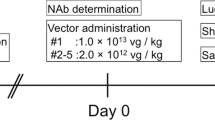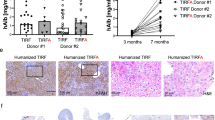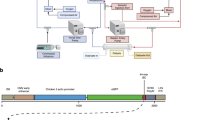Abstract
The effect of complement on transgene expression was evaluated in vivo and in vitro using mice lacking complement components. Complement component 3 (C3) deficient mice (C3−/−) and appropriate wild-type controls were intravenously injected with a replication incompetent, luciferase-expressing normal Ad5 (Ad5Luc1), or fibritin-fiber Ad5 (Ad5FFLuc1). Repeated, noninvasive bioluminescence imaging was conducted over 35 days. Our data show for the first time that C3 facilitates both short- and long-term hepatic expression of luciferase following systemic delivery. C3−/− mice showed significantly less (P<0.05) luciferase expression in their liver than treatment-matched wild-type mice when 2.3 × 109 (Ad5Luc1) and 4.0 × 109 (Ad5Luc1 or Ad5FFLuc1) viral particles (v.p.) were infused. The maximal difference in luciferase activity between C3−/− and wild-type mice was 99-fold difference at 3 days for the 2.3 × 109 v.p. dose (Ad5Luc1), 35-fold at 13 days for the 4.0 × 109 v.p. dose (Ad5Luc1), and 22-fold at 13 days for the 4.0 × 109 v.p. dose (Ad5FFLuc1). Preincubation of Ad5Luc1 with wild-type, C1q−/−, or factor B (FB) deficient mouse sera for 5 min significantly (P<0.05) increased transduction of mouse liver cells, as compared to preincubation with C3−/− sera or PBS. These results suggest the classical or alternate complement pathway enhances Ad5-mediated liver transduction.
This is a preview of subscription content, access via your institution
Access options
Subscribe to this journal
Receive 12 print issues and online access
$259.00 per year
only $21.58 per issue
Buy this article
- Purchase on Springer Link
- Instant access to full article PDF
Prices may be subject to local taxes which are calculated during checkout




Similar content being viewed by others
References
Jooss K, Chirmule N . Immunity to adenovirus and adeno-associated viral vectors: implications for gene therapy. Gene Ther 2003; 10: 955–963.
Zaiss AK et al. Differential activation of innate immune responses by adenovirus and adeno-associated virus vectors. J Virol 2002; 76: 4580–4590.
Walport MJ . Complement. First of two parts. N Engl J Med 2001; 344: 1058–1066.
Walport MJ . Complement. Second of two parts. N Engl J Med 2001; 344: 1140–1144.
Cichon G et al. Complement activation by recombinant adenoviruses. Gene Ther 2001; 8: 1794–1800.
Tao N et al. Sequestration of adenoviral vector by Kupffer cells leads to a nonlinear dose response of transduction in liver. Mol Ther 2001; 3: 28–35.
Einfeld DA et al. Reducing the native tropism of adenovirus vectors requires removal of both CAR and integrin interactions. J Virol 2001; 75: 11284–11291.
Kirby I et al. Identification of contact residues and definition of the CAR-binding site of adenovirus type 5 fiber protein. J Virol 2000; 74: 2804–2813.
Kirby I et al. Mutations in the DG loop of adenovirus type 5 fiber knob protein abolish high-affinity binding to its cellular receptor CAR. J Virol 1999; 73: 9508–9514.
Santis G et al. Molecular determinants of adenovirus serotype 5 fibre binding to its cellular receptor CAR. J Gen Virol 1999; 80 (Part 6): 1519–1527.
Nakamura T, Sato K, Hamada H . Reduction of natural adenovirus tropism to the liver by both ablation of fiber-coxsackievirus and adenovirus receptor interaction and use of replaceable short fiber. J Virol 2003; 77: 2512–2521.
Dechecchi MC, Tamanini A, Bonizzato A, Cabrini G . Heparan sulfate glycosaminoglycans are involved in adenovirus type 5 and 2-host cell interactions. Virology 2000; 268: 382–390.
Shayakhmetov DM et al. Binding of adenovirus fiber knob to blood coagulation factors mediates CAR-independent liver tropism. Mol Ther 2003; 7: S165.
Circolo A et al. Genetic disruption of the murine complement C3 promoter region generates deficient mice with extrahepatic expression of C3 mRNA. Immunopharmacology 1999; 42: 135–149.
Statistical Analyses System (SAS). Release 8.0. SAS Institute Inc.: Cary, NC, 1999.
Krasnykh V et al. Genetic targeting of an adenovirus vector via replacement of the fiber protein with the phage T4 fibritin. J Virol 2001; 75: 4176–4183.
Gaggar A, Shayakhmetov DM, Lieber A . CD46 is a cellular receptor for group B adenoviruses. Nat Med 2003; 9: 1408–1412.
Fernie-King B, Seilly DJ, Davies A, Lachmann PJ . Subversion of the innate immune response by micro-organisms. Ann Rheum Dis 2002; 61 (Suppl 2): ii8–ii12.
Fernie-King BA, Seilly DJ, Davies A, Lachmann PJ . Streptococcal inhibitor of complement inhibits two additional components of the mucosal innate immune system: secretory leukocyte proteinase inhibitor and lysozyme. Infect Immun 2002; 70: 4908–4916.
Lachmann PJ . Microbial subversion of the immune response. Proc Natl Acad Sci USA 2002; 99: 8461–8462.
Duthy TG et al. The human complement regulator factor H binds pneumococcal surface protein PspC via short consensus repeats 13 to 15. Infect Immun 2002; 70: 5604–5611.
Meri T et al. The yeast Candida albicans binds complement regulators factor H and FHL-1. Infect Immun 2002; 70: 5185–5192.
Meri T et al. Onchocerca volvulus microfilariae avoid complement attack by direct binding of factor H. J Infect Dis 2002; 185: 1786–1793.
Stoiber H, Speth C, Dierich MP . Role of complement in the control of HIV dynamics and pathogenesis. Vaccine 2003; 21 (Suppl 2): S77–S82.
Ikeda K et al. Oncolytic virus therapy of multiple tumors in the brain requires suppression of innate and elicited antiviral responses. Nat Med 1999; 5: 881–887.
Ikeda K et al Complement depletion facilitates the infection of multiple brain tumors by an intravascular, replication-conditional herpes simplex virus mutant. J Virol 2000; 74: 4765–4775.
Suresh M et al. Complement component 3 is required for optimal expansion of CD8T cells during a systemic viral infection. J Immunol 2003; 170: 788–794.
Dmitriev IP, Kashentseva EA, Curiel DT . Engineering of adenovirus vectors containing heterologous peptide sequences in the C terminus of capsid protein IX. J Virol 2002; 76: 6893–6899.
Vanderkwaak TJ et al. An advanced generation of adenoviral vectors selectively enhances gene transfer for ovarian cancer gene therapy approaches. Gynecol Oncol 1999; 74: 227–234.
Yull FE et al. Bioluminescent detection of endotoxin effects on HIV-1 LTR-driven transcription in vivo. J Histochem Cytochem 2003; 51: 741–749.
Acknowledgements
Research support was derived from NIH Grant Numbers CA80104 and 5P50CA089019, as well as DAMD17-02-01-0266. We thank Glorisa Reason for assistance with liver assays.
Author information
Authors and Affiliations
Rights and permissions
About this article
Cite this article
Zinn, K., Szalai, A., Stargel, A. et al. Bioluminescence imaging reveals a significant role for complement in liver transduction following intravenous delivery of adenovirus. Gene Ther 11, 1482–1486 (2004). https://doi.org/10.1038/sj.gt.3302331
Received:
Accepted:
Published:
Issue Date:
DOI: https://doi.org/10.1038/sj.gt.3302331
Keywords
This article is cited by
-
Direct interaction of human serum proteins with AAV virions to enhance AAV transduction: immediate impact on clinical applications
Gene Therapy (2017)
-
Experimental virotherapy of chemoresistant pancreatic carcinoma using infectivity-enhanced fiber-mosaic oncolytic adenovirus
Cancer Gene Therapy (2014)
-
CR1/2 is an important suppressor of Adenovirus-induced innate immune responses and is required for induction of neutralizing antibodies
Gene Therapy (2009)
-
Substitution of Hexon Hypervariable Region 5 of Adenovirus Serotype 5 Abrogates Blood Factor Binding and Limits Gene Transfer to Liver
Molecular Therapy (2008)
-
The Influence of Blood on In Vivo Adenovirus Bio-distribution and Transduction
Molecular Therapy (2007)



